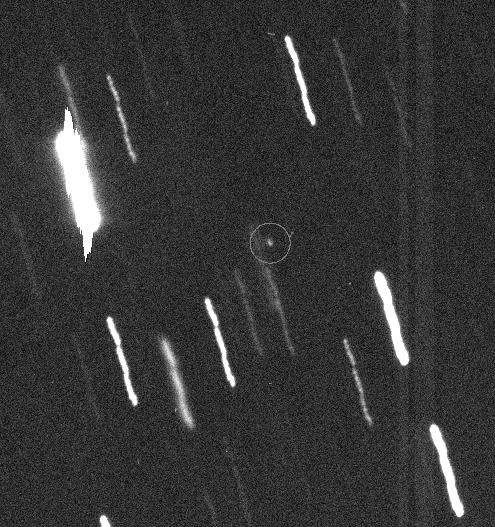The asteroid Apophis isn't likely to hit Earth. But if it did, what could we do?

In June of 2004, astronomers Roy Tucker, David Tholen, and Fabrizio Bernardi discovered a 340-meter asteroid while working at the Kitt Peak National Observatory in Arizona. The object was dubbed Apophis, after the serpent-like enemy of Ra from Egyptian myth. At first glance, the trajectory of Apophis suggested a slight chance it might have a run-in with Earth in 2029, but experts quickly ruled that possibility out.
The 2029 pass will bring it in close, about 20,000 miles from Earth’s surface. That’s near enough to watch with the naked eye, so long as you live in the Southern Hemisphere.
The Earth’s gravity will alter Apophis’s orbit, widening it, and it’s expected to make another flyby in 2068. The probability that it will impact Earth at that time was originally calculated at 1 in 150,000, but based on recent observations, those models need retooling.
New data informs us that Apophis is drifting outside of our previous projections, and the Sun is the likely culprit. Uneven solar heating causes objects like Apophis to radiate heat from one side more than another, and that little bit of energy gives it an extra push. Over time, this can considerably alter its orbit. This is known as the Yarkovsky effect.
At current, the drift accounts for a variance of approximately 557 feet per year when compared against prior models and is enough to call our impact projections into question. All of that said, there’s little reason to worry about an impact with Apophis in 2068 or any other year. Which is great news for us, because Apophis isn’t large enough to be a planet killer, but were it to make contact, it would not be our best day.
CALCULATING IMPACT PROBABILITIES
You might wonder why we don’t know for sure whether Apophis or any other known Near-Earth Object (NEO) will eventually make landfall. After all, classical mechanics is pretty well understood. It’s a rock, hurtling through space at the mercy of gravity and other natural forces. If we can predict a solar eclipse, if we can land a probe on an asteroid, why can’t we know this with certainty? What does it mean for an object to have a 1 in 150,000 chance of impacting?
The trouble isn’t in the physics, it’s in the available data. Large objects like planets, with orbits that remain stable over long periods of time, allow for extensive data collection. Each observation is an opportunity to refine our calculations. Objects like Apophis aren’t as cooperative. Newly discovered objects provide fewer opportunities for observation, and relatively small objects present the challenge of resolution. With regard to Apophis, we’re just not able yet to see it clearly enough to predict its orbit with precision.
Instead, possible orbits are modeled based on the available information. If the data allows for 1,000 possible orbits and one of those orbits impacts with Earth, then the probability of impact is calculated at 1 in 1,000. We know where Earth will be in 2029 and 2068 when the flybys happen, we’re just not sure where Apophis will be.
Over time, with more observations, or as we learn more about an object (like that it’s being pushed by the Yarkovsky effect), our predictions become more precise. Some of those possible orbits are ruled out and, generally speaking, the probability of impact decreases.
In the very, very unlikely chance it did hit Earth, though, what could we do about it?
PLANETARY DEFENSE
The Center for Near-Earth Object Studies (CNEOS) at NASA's Jet Propulsion Laboratory tracks all known NEOs and their impact probabilities so we can act quickly if the need arises. Let’s imagine, then, we draw the cosmic short straw and our new calculations put Apophis firmly in the "It’s-Coming-For-A-Visit" category and we had years to prepare and prevent the impact, what could we do?
The obvious and most sure answer for something like Apophis is to evacuate the area. An object of that size wouldn’t threaten humanity on the whole but it would be devastating for a considerable portion of the planet. If we can’t stop it or change its trajectory, we would need to get out of the way. An effort of that scale would require global cooperation as millions of individuals would become the first space-driven refugees. And depending on the asteroid’s size, density, speed, and angle of approach, such an evacuation might not even be feasible.
For the sort of impact that inspired movies like Armageddon (1998) and Deep Impact (also 1998), we’d need to science it up a bit more to alter the asteroid’s path such that it avoids Earth entirely.
One option involves nuclear bombs, because of course it does, but probably not in the way you’d expect. In Armageddon, a team of drillers travels to a planet-killing asteroid in a last-ditch effort to plant a bomb and split the object in two. In the film, the bomb splits the asteroid in two and both halves narrowly miss the planet.
While a nuclear bomb is a plausible tactic for deflecting an incoming asteroid, blowing it up is not the best strategy. Research suggests it would have little effect.
Planting a nuclear explosive inside an asteroid might cause it to crack and break apart, but the gravitational force of the remaining core could pull everything back together. And, it might not do enough damage to significantly alter the asteroid's trajectory. Instead, we could detonate a nuclear device near the object. The blast would heat that side of the asteroid and move it off course in much the same way the Yarkovsky effect is altering Apophis' route.
The major challenges here are overcoming public discomfort with nuclear explosives and the danger of the device detonating over Earth if the launch goes awry. Luckily, we have other options, and the laws of physics are on our side.
An impact with Earth depends on not only the two orbits intersecting, but the two objects being at the same point in their orbit at the same time. So, to prevent an impact, all we need to do is change the position or velocity of one of the objects along its orbit. Moving Earth would be a massive undertaking (pun intended) and probably not the best idea. We’d need to move the asteroid.
We could move it to one side or the other so that its orbit changes, or we could speed it up or slow it down so it passes the intersection point before or after Earth is there. One way to do that is to park a large spacecraft nearby as a gravitational tugboat to pull the asteroid off course.
This plan depends either on an incredibly large craft or a long period of time, but it would work. We could also send a series of crafts on a collision course with the object, using the kinetic energy to nudge it out of the way. Finally, a series of high-powered lasers could heat parts of the asteroid or blast portions off, using the energy of those interactions to push it.
All of these plans rely on the same general concept: acting upon the object in a meaningful way and across a long enough timespan that it ends up flying by rather than colliding.
There are countless objects zooming around in the great cosmic dark. Some of them, like Apophis, we’re aware of and studying. Others, we don’t even know exist. Luckily, the largest objects are the easiest to see and plan for. Given enough time and sufficient cooperation, the problem is not outside our capacity to handle if we keep our eyes to the skies.




























